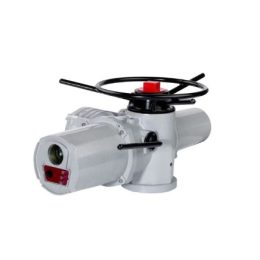
Pneumatic Actuated Ball Valve
Pneumatic Actuated Ball Valve Description
A Pneumatic Actuated Ball Valve is a type of ball valve that uses a pneumatic actuator to control its operation. Due to its quick execution speed of up to 0.05 seconds per cycle, it is also commonly referred to as a “pneumatic fast cut off ball valve.” This valve is typically equipped with various accessories such as solenoid valves, air source treatment triplets, limit switches, positioners, and control boxes. It is suitable for use with a wide range of working media, including general media, hydrogen peroxide, methane, and ethylene.
Pictures of Pneumatic Actuated Ball Valve

Technical Specifications:
| Specification | Description |
|---|---|
| Sizes | NPS 2 to NPS 48 |
| Pressure Class | 150 to 2500 |
| Forged Materials | A105, A182 F304, F304L, F316, F316L, F51, F53, A350 LF2, LF3, LF5 |
| Casting Materials | A216 WCB, A351 CF3, CF8, CF3M, CF8M, A995 4A, 5A, A352 LCB, LCC, LC2 |
| Other Materials | Monel, Inconel, Hastelloy |
| Connection | RF, RTJ, or BW |
| Cover | Bolted |
| Screen Type | Perforable or Mesh Lined Stainless Steel |
| Bore | Full or Reduced |
| Entry Design | Side or top |
| DBB | Double Block & Bleed (DBB),Double Isolation & Bleed (DIB) |
| Seat Injection | Emergency seat and stem injection |
| Anti-Static | Anti-Static Device |
| Anti-Blow out | Anti-Blow out Stem |
| Temperature | Cryogenic or High Temperature Extended Stem |
| Operator | Single Acting Pneumatic Actuator / Double Acting Pneumatic Actuator |
Design Standard
Design & manufacture according to API 6D, API 608, ISO 17292
Face-to-face according to API 6D, ASME B16.10
End Connection according to ASME B16.5, ASME B16.47, MSS SP-44 (NPS 22 Only)
Test & inspection according to API 6D, API 598
Fire safe design according to API 6FA, API 607
Also available per NACE MR-0175, NACE MR-0103, ISO 15848
Control and Operation
One of the key benefits of Pneumatic Actuated Ball Valve is its ability to be controlled both locally and centrally from a distance. This makes it a highly efficient valve, saving on both human resources and time while also providing greater safety. The valve can be operated with either a single acting or double acting pneumatic actuator, making it highly versatile for different applications.

Features of Pneumatic Actuated Ball Valves
Pneumatic actuated ball valves come in various sizes, materials, and designs to meet different application requirements. Here are some of the features to consider when selecting a pneumatic actuated ball valve:
- Valve Size: Pneumatic actuated ball valves are available in a wide range of sizes, ranging from NPS 2 to NPS 48 or greater.
- Valve Class: 150 to 2500
- Valve Material: The Pneumatic Actuated Ball Valve is available in different materials, including: Forged (A105, A182 F304, F304L, F316, F316L, F51, F53, A350 LF2, LF3, LF5,) Casting (A216 WCB, A351 CF3, CF8, CF3M, CF8M, A995 4A, 5A, A352 LCB, LCC, LC2), Monel, Inconel, and Hastelloy. The valve’s material selection depends on the fluid or gas being handled, temperature, and pressure requirements.
- Valve Body Material: The valve body can be made of different materials, such as stainless steel, carbon steel, brass, or plastic, depending on the fluid or gas being handled.
- Seat Material: The seat is the part of the valve that provides a tight seal between the ball and the valve body. The seat material can be made of various materials, such as PTFE, RPTFE, or metal, depending on the temperature and pressure of the fluid or gas.
- End Connections: Pneumatic actuated ball valves can have different end connections, such as threaded, flanged, or welded.
- Actuator Type: The actuator can be either double-acting or spring-return, depending on the application requirements.
Pneumatic ball valves widely used in industries.
Pneumatic actuated ball valves are widely used in various industries, including:
- Chemical and Petrochemical: Pneumatic actuated ball valves can handle corrosive and hazardous chemicals and can be used for on-off or control applications.
- Oil and Gas: Pneumatic actuated ball valves are suitable for pipeline and tank isolation, as well as flow control.
- Water and Wastewater: Pneumatic actuated ball valves can handle clean water, sewage, and slurry applications.
- Food and Beverage: Pneumatic actuated ball valves are ideal for hygienic applications, such as food and beverage processing.
- HVAC: Pneumatic actuated ball valves can be used for heating, ventilation, and air conditioning systems.

Advantages of Pneumatic Actuated Ball Valves
Pneumatic actuated ball valves offer several advantages over other types of valves, including:
- Quick and Easy Operation: Pneumatic actuated ball valves can be opened or closed in just a few seconds, making them ideal for applications that require fast and frequent operation.
- High Flow Rates: Because of their full-bore design, pneumatic actuated ball valves can provide high flow rates with minimal pressure drop, which can result in energy savings.
- Low Maintenance: Pneumatic actuated ball valves have a simple design with few moving parts, making them easy to maintain and repair.
- Durability: Pneumatic actuated ball valves are made of high-quality materials that can withstand harsh environments and corrosive fluids.
Why Choose Our Pneumatic Actuated Ball Valve?
At Fluid-Valves, we offer high-quality pneumatic actuated ball valves that are designed to meet the unique needs of various industries. Our valves are manufactured using high-grade materials and cutting-edge technology, ensuring that they are durable, reliable, and long-lasting. In this article, we will outline some of the reasons why our pneumatic actuated ball valve is the best choice for your business needs.



